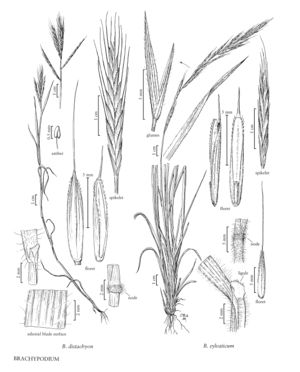Brachypodium sylvaticum
Plants perennial; cespitose, sometimes shortly rhizomatous. Culms 30-120(200) cm, erect or ascending, usually unbranched, with (3)4-6(12) nodes, internodes smooth, pubescent adjacent to the nodes; nodes pubescent. Sheaths rounded or keeled distally, smooth, usually hairy, sometimes glabrous, hairs spreading to reflexed; ligules 1-3.5(5-6) mm, obtuse, pubescent, erose-ciliate; blades 8-35 cm long, (4)5-12(15) mm wide, flat, lax, scabrous, both surfaces sparsely pilose, hairs 0.8-1.8 mm, abaxial surfaces often with a tuft of hairs near the base, adaxial surfaces not prominently veined, veins pale, sparsely pilose. Racemes (2)4-20 cm, suberect to pendent, with (3)4-12 rather distant spikelets; pedicels 0.5-2 mm. Spikelets 17-30(55) mm, terete, with 6-16(22) florets. Glumes unequal, acute, usually pubescent; lower glumes 6-9 mm, 5-7-veined; upper glumes 8-11 mm, 7-9-veined; lemmas 6-12(13.5) mm, lanceolate, 7-veined, awned, awns 7-15 mm, straight or weakly flexuous; paleas (5)6-10(12) mm, narrowly oblong, 2-keeled; anthers 3-4(5.5) mm. Caryopses 5-8.7 mm. 2n = 16, 18.
Distribution
Oreg.
Discussion
Brachypodium sylvaticum is native to Eurasia and northern Africa, where it grows in woods and other shady places. In the Flora region, it is established in Oregon, where it is an aggressive weed that has spread to several western counties since its first discovery in Eugene, Lane County, in 1939 (False-Brome Working Group 2006). In December 2003 it was discovered in California. Many of the locations are in nature preserves of some kind, with humans being the primary dispersers; hikers are being urged to clean their shoes and clothing before and after hiking in affected locations. An additional report from Virginia has been confirmed. A report from Utah (Hull 1974) was not supported by voucher specimens; attempts to locate the species in 2004 and 2005 were unsuccessful.
Brachypodium sylvaticum has sometimes been cultivated as an ornamental, but because of its ability to become an aggressive weed, such use is discouraged in the Flora region.
Plants in the Flora region belong to Brachypodium sylvaticum (Huds.) P. Beauv. subsp. sylvaticum, which has retrorsely pubescent sheaths, green leaves, green hairy lemmas, and spikelet lengths within the lower portion of the range given. Specimens with glabrous sheaths belong to B. sylvaticum subsp. glaucovirens (St.-Yves) Murb.
Selected References
None.
